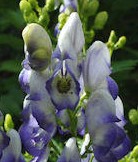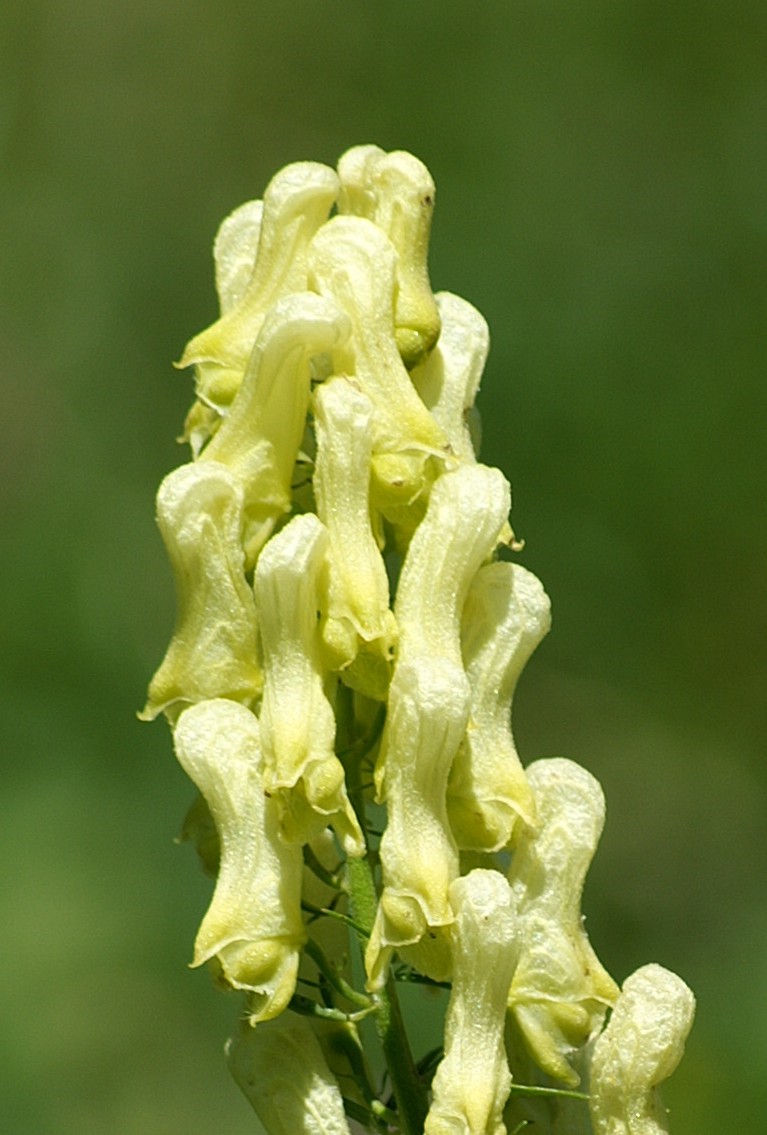 A member of the buttercup family, this genus includes over 250 species and is known by many names including monkshood,wolfsbane, and devil’s helmet. These common names refer to the fact that the flower has an enlarged sepal that resembles the hood of a monk, the roots were used to poison wolves, and the flower resembles a helmet. The roots, stems, and leaves of the plant are poisonous, giving rise to the Latin name Aconitum, from the Greek word, akoniton, which may refer to javelins or darts tipped with poison.
A member of the buttercup family, this genus includes over 250 species and is known by many names including monkshood,wolfsbane, and devil’s helmet. These common names refer to the fact that the flower has an enlarged sepal that resembles the hood of a monk, the roots were used to poison wolves, and the flower resembles a helmet. The roots, stems, and leaves of the plant are poisonous, giving rise to the Latin name Aconitum, from the Greek word, akoniton, which may refer to javelins or darts tipped with poison.
In spite their poisonous properties, aconites make excellent garden plants. They bloom in late summer to fall when other garden plants are spent. The flowers are usually a shade of blue but may be yellow or rose, and are carried in terminal racemes or panicles. Each flower consists of The dark green leaves are usually palmately divided. Aconites do best in areas with cool nights (below 70 F), moisture retentive well-drained soil, and full sun to partial shade especially in the southern limit of their range. Because their poisonous roots are fleshy they can be mistaken for cultivated plants so should be planted away from root crops like horseradish. The roots do not like to be disturbed so choose the site carefully. Aconites make good cut flowers.
Pyrenees Monkshood (A. anthora)
 Native to southern Europe, this aconite has rounded, pale yellow ½ “ to ¾ “ flowers and finely divided leaves 2”-5”.
Native to southern Europe, this aconite has rounded, pale yellow ½ “ to ¾ “ flowers and finely divided leaves 2”-5”.
Size: 2’ H x 1.5’ W
Bloom Time: Summer
Color: Pale yellow
Hardiness: Zones 3-6
Bicolor Monkshood (A. x bicolor)
 Probably a cross between A. variegatum and A. napellus, the plants are variable in habit with some being spreading while others are stiff and erect. Leaves are 2-3” and deeply divided. Several cultivars are available varying in flower color and height.
Probably a cross between A. variegatum and A. napellus, the plants are variable in habit with some being spreading while others are stiff and erect. Leaves are 2-3” and deeply divided. Several cultivars are available varying in flower color and height.
Size: 2.5-5’ H x 2’ W
Bloom Time: Summer
Color: Various shades of blue
Hardiness: Zones 3-7
Azure Monkshood (A. carmichaelii)
 A rigid, sturdy clump former that rarely needs staking, A. carmichaelii has dark purplish blue flowers and relatively thick leathery leaves that are cleft almost to the base.
A rigid, sturdy clump former that rarely needs staking, A. carmichaelii has dark purplish blue flowers and relatively thick leathery leaves that are cleft almost to the base.
Size: 2-4’H x 2’ W
Bloom Time: Late summer to early fall
Color: Dark purplish blue
Hardiness: Zones 3-7
Autumn Monkshood (A. henryi ‘Spark’s Variety’)
 Although similar to A. carmichaelii, it differs by having thinner leaves, tapering stems, and earlier bloom time. Its flowers are deep violet blue and carried in loose widely branched clusters.
Although similar to A. carmichaelii, it differs by having thinner leaves, tapering stems, and earlier bloom time. Its flowers are deep violet blue and carried in loose widely branched clusters.
Size: 3-5’ H x 2’ W
Bloom Time: Summer
Color: Deep violet blue
Hardiness: Zones 3-7
Common Monkshood (A. napellus)
 The old stand by species, it has leaves 2-4” that are so divided they appear linear. The deep violet blue flowers have helmets that are wider than tall are densely packed on terminal racemes that are much longer than other stems. Cut back after first bloom for second flush. A pink flowered cultivar, ‘Caeneum’ is available but fades where evenings are warm.
The old stand by species, it has leaves 2-4” that are so divided they appear linear. The deep violet blue flowers have helmets that are wider than tall are densely packed on terminal racemes that are much longer than other stems. Cut back after first bloom for second flush. A pink flowered cultivar, ‘Caeneum’ is available but fades where evenings are warm.
Size: 3-5’ H x 1’ W
Bloom Time: Late summer
Color: Dark blue
Hardiness: Zones 3-7
Aconitum vulparia
 This cream flowered species may be sprawling or upright and is not as common as the blue flowered ones. The leaves are deeply divided and lobed.
This cream flowered species may be sprawling or upright and is not as common as the blue flowered ones. The leaves are deeply divided and lobed.
Size: 3-5 H x 1.5’ W
Bloom Time: Summer to early fall
Color: Cream
Hardiness: Zones 5-8